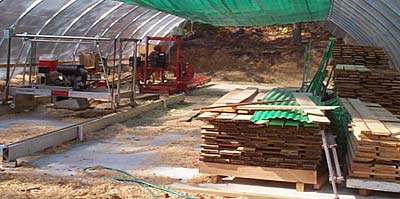Honeycomb and Checking with Mixed Kiln Loads
Advice on limiting honeycomb defects in Red Oak during kiln-drying operations. September 6, 2010
Question
Is there a special procedure for drying 4/4 8' & R with large starting moisture differentials? We have 100,000 board foot kilns and starting moistures per each kiln can be anywhere from 25 to 60%. Any special precautions to prevent damage to the lumber?
Forum Responses
(Sawing and Drying Forum)
From Professor Gene Wengert, forum technical advisor:
This is discussed in "Drying Hardwood Lumber" and also "Drying Oak Lumber". The conditions in the kiln used for the wet lumber will be too wet for the dry lumber. The surface of the dry lumber will therefore swell and if there are any checks, the checks will worsen substantially. The dry lumber will also cup quite a bit.
Note that the drying time in your kiln is determined by the wettest lumber. Therefore, you can address this problem by loading the kiln initially with as much wet lumber as you have. As the kiln conditions get drier and become appropriate for drier lumber (most likely for air-dried lumber, when the kiln gets to about 11 to 12% EMC) then add the drier, air-dried lumber. This is the best compromise, rather than mixing MCs.
From the original questioner:
Another issue we have been seeing is honeycomb/checking of the starting samples before and after sitting in the oven for 24 hours.
From Professor Gene Wengert, forum technical advisor:
99% of honeycomb is actually a surface check that worsened. So it does appear that your incoming lumber has some checking, which means do not let it regain moisture (which includes using too much humidity at startup).
From contributor S:
Gene, where can I find a copy of "Drying Oak Lumber"? I've searched the archives here as well as at Amazon, but to no avail. I have "Drying Hardwood Lumber", but not the oak book.
From Professor Gene Wengert, forum technical advisor:
If it is still available, contact Scott Bowe at the University of Wisconsin Forest Products Extension.
From contributor M:
I understand what you are saying about not initially loading the dryer of the air dried lumber, but rather holding off till the wetter lumber is closer to the well air dried lumber. Problem is I do not determine what is put in the kiln. It is after the kiln is loaded the lumber becomes my responsibility. Is there anything I can do to ensure the least amount of damage to the lumber?
From Professor Gene Wengert, forum technical advisor:
As the wettest lumber determines total drying time, waiting with some of the lumber will not require any longer drying cycles. Tell your boss about that. As far as what you can do, make sure that you start the kiln at an EMC or RH that is no wetter than is required. But with such a large spread of MCs, you are limited in what you can do to prevent internal checking (honeycomb) and cupping.
